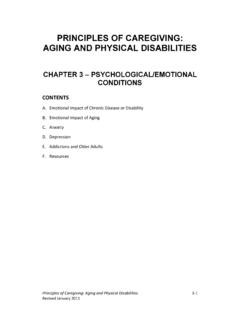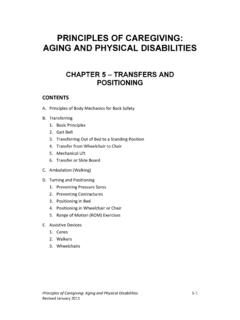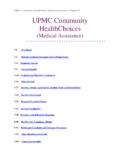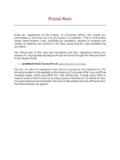Transcription of CHAPTER 4 – PERSONAL CARE - azdirectcare
1 PRINCIPLES OF CAREGIVING: AGING AND PHYSICAL DISABILITIES. CHAPTER 4 PERSONAL care . CONTENTS. A. Basic Principles 1. Following Service Plans 2. Activities of Daily Living (ADLs). 3. Client Dignity and Rights 4. Cultural and Religious Issues 5. Observing and Reporting B. Skin care 1. Bruises and Cuts 2. Pressure Ulcers C. Bathing, Dressing, Grooming 1. Skin care 2. Bathing 3. Hair care 4. Dressing 5. Shaving 6. Nail care 7. Foot care 8. Oral care D. Toileting 1. Urinary Incontinence 2. Incontinence Pads 3. Catheter care 4. Ostomy care 5. Use of a Bedpan 6. Skin care After Toileting Principles of Caregiving: Aging and Physical Disabilities 4-1. Revised January 2011. CHAPTER 4 PERSONAL care E. Assistive Devices for Bathing F. Meal Assistance 1. Assistance with Setting Up a Meal 2. Assistance with Eating 3. Feeding an Individual who has Difficulty Swallowing 4. Feeding an Individual with a Cognitive Disability 5. Encouraging Appetite 6.
2 Assistive Devices for Eating Principles of Caregiving: Aging and Physical Disabilities 4-2. Revised January 2011. CHAPTER 4 PERSONAL care OBJECTIVES. 1. Identify and describe activities of daily living and instrumental activities of daily living. 2. Explain the importance of observing client rights, dignity, and cultural preferences. 3. Describe techniques for preventing skin damage and pressure ulcers. 4. Identify 3 or 4 characteristics of people who might be at risk for skin-integrity concerns. 5. List the most common causes of skin breakdown. 6. Identify and explain basic principles of PERSONAL care and demonstrate selected PERSONAL care skills. 7. Describe how to promote independent functioning and respect a person's privacy while providing PERSONAL care . SKILLS. Bed bath Assisting with dressing Assisting with oral care Emptying a catheter drainage bag Positioning on the bedpan Assisting with eating KEY TERMS. Activities of daily living (ADLs) Grab bar Ambulation Incontinence Aspiration Instrumental activities of daily living (IADLs).
3 Catheter Mobility Circulation Perineal care Friction Pressure ulcer Principles of Caregiving: Aging and Physical Disabilities 4-3. Revised January 2011. CHAPTER 4 PERSONAL care A. BASIC PRINCIPLES. 1. Following Service Plans Individuals, and their caregivers and health care providers will develop a service plan, also called a care plan or support plan. This is part of an assessment process for direct care assistance. It is based on the needs and the functional ability of the individual to perform activities. These are divided into activities of daily living (ADLs) and instrumental activities of daily living (IADLs). Direct care workers must follow the agreed-upon service plan. If the client wants you to do something that is not in the service plan, you may be opening yourself and the agency to disciplinary and/or liability issues. Contact your supervisor if such a situation arises. Refer to the explanation of care and support plans in the CHAPTER 6 of the Principles of Caregiving: Fundamentals course manual.
4 When beginning care for any individual, regardless of condition; whether a family member or regular client, remember to allow the client as much independence as possible. Clients should be encouraged to continue to do as much as they can for themselves. The DCW should: Resist the urge to do everything for them. This is not healthy for the client or the direct care worker. Ask the client/family to determine what they can do. Assist but don't take over the task. Do provide physical and emotional supportive. Be available to listen, and be sympathetic yet genuine. Review the service plan for instructions. Check to see if the person is independent, or at minimum or total assistance for tasks. Continue to communicate with the client and family. Needs and abilities may change, sometimes daily. 2. Activities of Daily Living (ADLs). Activities of daily living are considered a person's basic self- care tasks. They include the ability to: Dress.
5 Eat. Ambulate (walk). Toilet. Take care of hygiene needs ( , bathing, grooming). Principles of Caregiving: Aging and Physical Disabilities 4-4. Revised January 2011. CHAPTER 4 PERSONAL care There are also instrumental activities of daily living (IADLs). These activities are important for functioning in the community and include the ability to: Shop. Keep house. Manage PERSONAL finances. Prepare food. Transport (drive, ride the bus, etc.). The DCW's assistance with ADLs and IADLs helps fill the gap between what the person can do independently and what he/she needs help with. But for each activity that the DCW does, the client has a little less control and may lose out on being able to exercise the muscles and joints involved in the activity. This section focuses on the PERSONAL care needs the ADLs and how to provide assistance to meet those needs. Assistance with some IADLs (housekeeping, food preparation) is addressed in the Fundamentals course manual.
6 3. Client Dignity and Rights The DCW's responsibility is to help an individual maintain normal function, or to compensate for or regain lost function. The DCW must do so in a professional manner. This preserves the person's dignity. An example is not exposing more of a person than is absolutely necessary during bathing. Offering choices is an important way to preserve dignity. Individualized person-centered services promote the principles of choice and respect. For example, individuals should be allowed to bathe at the time they desire and the way they prefer. Each person should choose what clothes to wear. One goal of PERSONAL care service is to provide assistance with an ADL, but it is also intended to maintain independence, renew and uplift the person's spirit. ! Client rights emphasize dignity, respect, choice, and empowerment (controlling what they can control). 4. Cultural and Religious Issues DCWs must appreciate the cultural differences between their own culture and the client's culture.
7 Respect the person's culture and demonstrate that appreciation and respect while providing services. For instance, for some in the Hindu religion, PERSONAL hygiene is very important. Bathing is required every day, but bathing after a meal may be viewed as causing injury. However, not all people who are Hindu hold the same beliefs, just as people with a Hispanic last name may not like Mexican food. For input on Principles of Caregiving: Aging and Physical Disabilities 4-5. Revised January 2011. CHAPTER 4 PERSONAL care individual cultural and religious issues ask the client, other caregivers, and your supervisor. Direct care workers should have warmth, empathy and genuineness. As discussed in CHAPTER 4, Cultural Competency, in the Fundamentals course manual, DCWs must also have a sense of compassion and respect for people who are culturally different. Just learning the behavior is not enough. When a person has an appreciation and respect for others they can display warmth, empathy and genuineness.
8 5. Observing and Reporting Proper documentation and reporting of PERSONAL care tasks is critical. Refer to CHAPTER 6, Observing, Reporting and Documenting, in the Fundamentals course manual for more details. While providing care such as bathing a client or applying lotion to a person's feet, be very observant of any changes in skin condition. If any changes are noted, they must be reported and documented immediately. Document to whom the report was given, what action was recommended, and the outcome of that action. A paid provider of care and support is expected to contact a supervisor, who will contact the appropriate parties to get the necessary assistance. Failing to contact anyone is viewed as negligence and can be grounds for an abuse investigation. Protect yourself against any liability or disciplinary action. ! Document and report your observations. Principles of Caregiving: Aging and Physical Disabilities 4-6. Revised January 2011.
9 CHAPTER 4 PERSONAL care B. SKIN care . Older adults and people with disabilities are susceptible to skin problems because of changes that happen as a person ages. Skin health can also be affected by medical conditions, pain, depression, confusion and/or injury. It is critical for a DCW to routinely check a client's skin for any changes and report changes to the supervisor. Early intervention is of utmost importance in maintaining a client's health and decreasing liability for the DCW and the agency. ! Contact your supervisor before proceeding with any action related to skin problems. 1. Bruises and Cuts A bruise is a common skin injury that results in a discoloration of the skin. Blood from damaged blood vessels deep beneath the skin collects near the surface of the skin resulting in what we see as a black and blue mark. Unexplained bruises that occur easily or for no apparent reason may indicate a bleeding disorder, especially if the bruising is accompanied by frequent nosebleeds or bleeding gums.
10 Notify your supervisor. Bruises in older adults frequently occur because the skin has become thinner with age. The tissues that support the underlying blood vessels have become more fragile. A cut, or laceration, refers to a skin wound. You can usually stop the bleeding by applying direct pressure over the wound with a clean cloth (or dressing). If the cut is on an extremity such as an arm or a leg, you can elevate the extremity. Washing the area with soap and water will help reduce the risk of infection. Cover the cut with an adhesive bandage. Depending on your agency's policies, you may need to report this to your supervisor. ! Remember to wear gloves with ANY and ALL blood exposures! Principles of Caregiving: Aging and Physical Disabilities 4-7. Revised January 2011. CHAPTER 4 PERSONAL care 2. Pressure Ulcers Pressure ulcers, also called pressure sores, bed sores or decubitus ulcers, are lesions caused by unrelieved pressure resulting in damage to underlying tissue.












